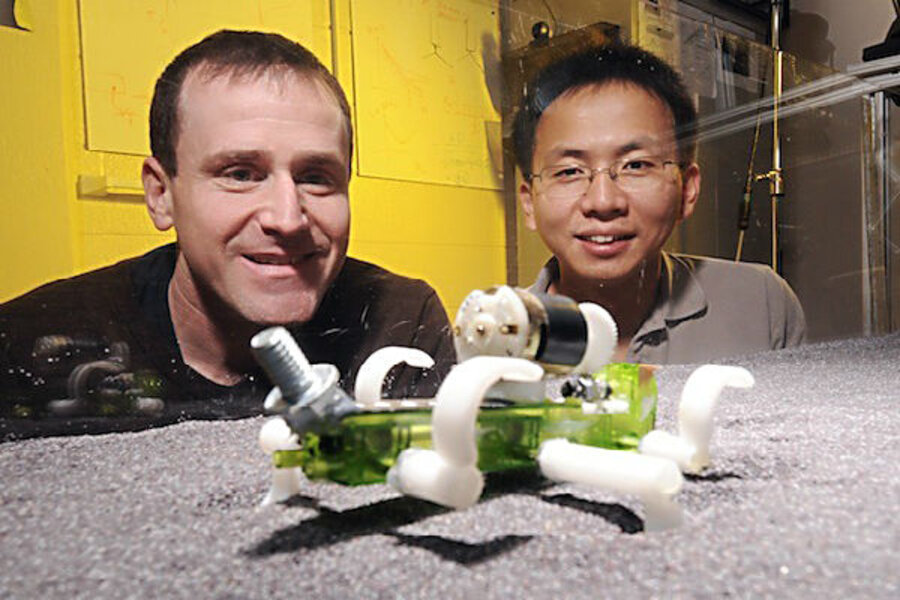Bow-legged robot can scamper across rugged terrain
Loading...
A six-legged, hamster-sized robot that can easily scamper across sand, gravel and similarly unstable surfaces could lead to better rovers for exploring Mars and other alien worlds, researchers say.
Such robots could also find use in search-and-rescue missions; for researchers, the robots could shed light on how animals such as sand lizards run and how kangaroo rats hop on grainy terrains, investigators added.
Scientists are increasingly designing robots that can go where humans can or should not venture. To create such machines, many inventors are taking inspiration from nature, analyzing how animals roam across landscapes. For instance, snake-like robots might slither into crevices to help find disaster victims.
Surfaces such as sand, gravel, soil and mud pose especially difficult challenges since these materials can flow around legs in ways that are often more complex than the movements of fluids like water. To learn how to best navigate grainy surfaces, researchers led by physicist Chen Li at the University of California at Berkeley experimented with a six-legged droid. It measures just 5 inches (13 centimeters) long and weighs about a third of a pound (150 grams), or about the length and weight of a pet hamster. Researchers used a 3D printer to create legs in a variety of shapes, then analyzed which ones helped the robot best scamper across poppy seeds, glass beads and natural sand. [See also: Robot Legs Mimic How Babies Walk]
Robo-legs
The results of these experiments closely matched simulations the researchers developed to predict the robot's motions. In addition, these findings revealed laws governing the walking behavior, which could be generalized across many different grainy materials. The results helped refine the robot's leg shape and walking style, with researchers arriving at a design that optimized each of the droid's steps.
"I was floored by how well the models developed by Li and Tingnan Zhang were able to predict the performance of the legged robots across a range of granular materials," researcher Daniel Goldman, a physicist at the Georgia Institute of Technology in Atlanta and supervisor of the project, told TechNewsDaily. (In a video, the robot scampers along very quickly.)
In the end, the best legs were convex, made in the shape of the letter "C." Compared to other leg designs, this shape helped the robot sink less and move faster when traversing beds of grains. The researchers estimate this robot reached a maximum speed of about 1.6 mph (2.6 km/h) and took about five steps per second.
"As long as the legs are convex, the robot generates large lift and small body drag, and thus can run fast," Goldman said. "When the limb shape was changed to flat or concave, the performance dropped. This information is important for optimizing the energy efficiency and performance of legged robots."
Although the robot is still not quite as effective at walking across sand and gravel as a lizard or insect, this research might help improve the performance of roving and walking droids such as Mars rovers.
"We can start looking at why certain desert organisms have specific feet shapes or other adaptations that may also help them move," Goldman said.
Animal movement
Ultimately, this work could help create and advance a field the researchers call "terradynamics" that predicts how animals, robots and vehicles move on grainy and other complex surfaces, akin to how aerodynamics helps analyze motion through the air and hydrodynamics studies movement in water.
"Just as a good understanding of aerodynamics and hydrodynamics has allowed us to create devices with unprecedented mobility in air and water, this work can help us take the next step — no pun intended — toward greater mobility on more complex ground," Goldman told TechNewsDaily.
Future research can explore what leg and foot shapes and stride patterns work best on surfaces made of irregularly shaped grains, surfaces made of grains with various shapes and sloped surfaces such as sand dunes. Studies can also investigate the benefits of springy versus rigid limbs.
"We can also not just look at animals living now, but also ones from the past," Goldman said. "What kind of feet did the first animals that walked on land have? Presumably they were walking on soft materials, since they were near the water. Did they have limbs that helped them walk on those?"
Li, Zhang and Goldman detailed their findings in the upcoming March 22 issue of the journal Science.
- 10 Animal-Inspired Robots
- Amazing Mars Discoveries by Rovers Spirit & Opportunity
- Top 7 Useful Robots You Can Buy Right Now
Copyright 2013 TechNewsDaily, a TechMediaNetwork company. All rights reserved. This material may not be published, broadcast, rewritten or redistributed.







